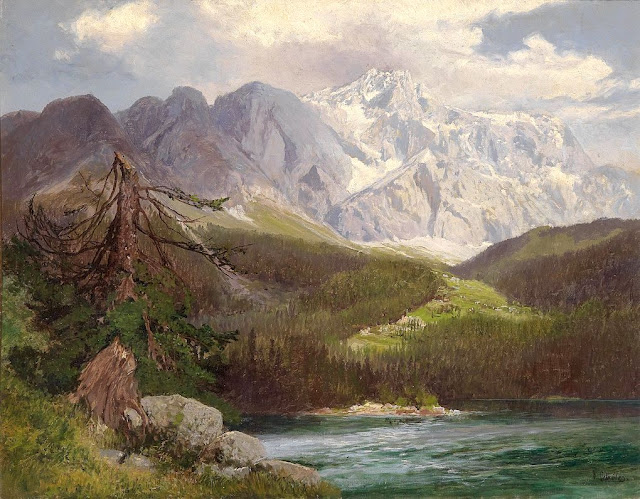KONRAD PETRIDES (1864-1944)
Hoher Dachstein (2, 995m - 9, 826ft)
Austria
In Dachstein mit Gosausee, 1899, Private collection
The mountain
The Dachstein (2, 995m - 9, 826ft) is a strongly karstic Austrian mountain, and the second highest mountain in the Northern Limestone Alps. It is situated at the border of Upper Austria and Styria in central Austria, and is the highest point in each of those states. Parts of the massif also lie in the state of Salzburg, leading to the mountain being referred to as the Drei-Lander-Berg ("three-state mountain"). The Dachstein massif covers an area of around 20x30 km with dozens of peaks above 2,500 m, the highest of which are in the southern and south-western areas. Seen from the north, the Dachstein massif is dominated by the glaciers with the rocky summits rising beyond them. By contrast, to the south, the mountain drops almost vertically to the valley floor.
The summit was first reached in 1832 by Peter Gappmayr, via the Gosau glacier, after an earlier attempt by Erzherzog Karl via the Hallstätter glacier had failed. Within two years of Gappmayr's success a wooden cross had been erected at the summit. The first person to reach the summit in winter was Friedrich Simony, on 14 January 1847. The sheer southern face was first climbed on 22 September 1909 by the brothers Irg and Franz Steiner.
Being the highest point of two different Bundesländer, the summit is a popular goal in both summer and winter. In fine weather as many as 100 climbers may be attempting the ascent, leading to congestion at key sections of the climb.
The summit was first reached in 1832 by Peter Gappmayr, via the Gosau glacier, after an earlier attempt by Erzherzog Karl via the Hallstätter glacier had failed. Within two years of Gappmayr's success a wooden cross had been erected at the summit. The first person to reach the summit in winter was Friedrich Simony, on 14 January 1847. The sheer southern face was first climbed on 22 September 1909 by the brothers Irg and Franz Steiner.
Being the highest point of two different Bundesländer, the summit is a popular goal in both summer and winter. In fine weather as many as 100 climbers may be attempting the ascent, leading to congestion at key sections of the climb.
The artist
Konrad Petrides was a Viennese landscape and stage painter in the studio Hermann Burghart, where the painters Anton Brioschi, Josef Kautsky, Georg Jany and Leopold Rothaug also worked. He also painted many veduras, especially from Lower Austria and East Tyrol. Petrides was a member of the Dürer League, in whose exhibitions he participated and whose silver medal he received in 1919. In 1904 he also received the gold medal at the World's Fair in St. Louis, USA.
_______________________________
2021 - Wandering Vertexes...
by Francis Rousseau





